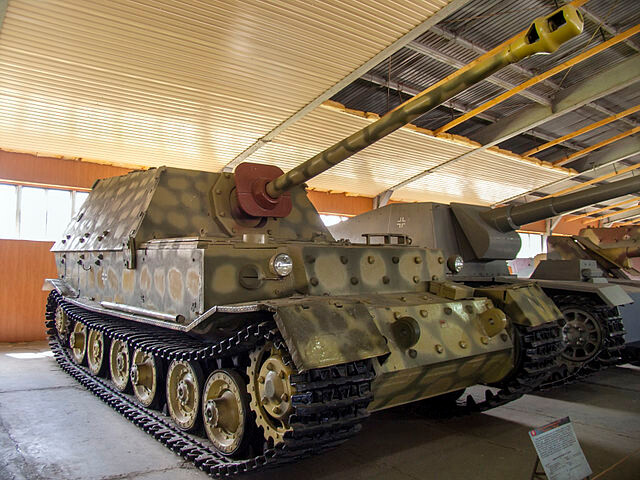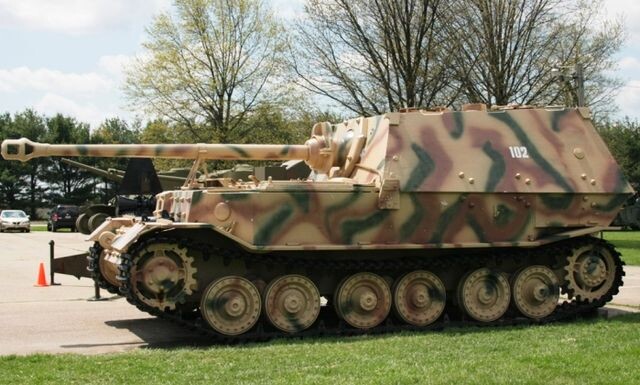The Ferdinand was the one of the first heavy tank destroyers produced by the Germans in any significant quantity, formed from Ferdinand Porsches overconfidence in the Tiger P. After the loss of the Tiger I contract, Ferdinand Porsche was left with 100 unusable chassis. In an effort to create a use for said chassis, the Ferdinand was born. With a heavily armoured superstructure and the formidable German 8,8 cm Pak 43/2 L/71, the Ferdinand was a fearsome opponent for any hostile tank that came across it. It utilised a generator to turn the engine’s power to electricity to power motors to turn the drive sprockets, making it a very early hybrid vehicle. This enabled it to reverse at the same speed as it could go foward.
While on paper being a force to be reckoned with, in reality the Ferdinand was a terrible curse on those assigned to it. Initially, with no anti-infantry machine gun, the only way for the crew to protect themselves was to fire a machine gun down the barrel, requiring the gun to be traversed to aim at the incoming assailants. The Ferdinand’s most famous letdown, however was its mobility. During its combat debut during the Battle of Kursk, all 90 were committed to the opening assault, with dozens being immobilised by mine damage in mere hours. Several more Ferdinands broke down and had to be destroyed by their crews to prevent capture. Soviet demolition teams went out during the night to blow up any abandoned Ferdinands that they could find.
Assessments of the combat proficiency proved that the 8,8 cm gun and 200 mm thick armour was more than satisfactory, with no cases of frontal armour penetration and even the heaviest Soviet AFVs at the time (KV-1, T-34) being defeated at ranges of 2000 m. Less than a year later, a report mentioned that the remaining 48 Ferdinands needed an engine replacement after 600 km and that track breakages were almost daily. The Russians had learned that they stood no chance of penetrating the frontal armour and began to focus their fire on the Ferdinand’s tracks and suspension.
In December 1943, a company in possession of the Ferdinands (Schwere Panzerjäger Regiment. 656) returned to Austria for a complete refit. The Ferdinands returned with several modifications, those being:
- A ball mounted machine gun.
- A new ventilation grating design over the engine.
- A new commander’s cupola with 7 vision blocks, the same used on the StuG III.
- The application of Zimmerit anti-magnetic mine paste.
The next major deployment of the Ferdinand was in February 1944, where 14 were deployed to destroy the Allied Anzio beachhead. This proved to be a mistake, as the mountainous roads caused many breakdowns. Only 2 Ferdinands were operational when the company was withdrawn to Germany in August 1944. The Ferdinands did not return to Germany as Ferdinands however, as they had been renamed to Elefants on May 1.
Two other companies in possession of a combined 28 Elefants had been sent to reinforce Army Group South’s positions near Tarnopol during 1944. The Elefants proved effective at blunting Soviet attacks, but there was a constant struggle to keep the Elefants in service due to a lack of recovery vehicles, which were so desperately needed by the Elefants. Elefants fought on the Eastern Front through 1944, albeit with declining numbers. In the autumn of 1944, an Elefant claimed the destruction of a T-34 from a range of 4500 m. The last Elefants are believed to have fought south of Berlin during 1945. The Elefant was a formidable opponent, plagued by the crumbling German war machine.
Specifications
- Armament: 8,8cm Pak 43/2 L/71
- Engine: 2x Maybach HL120 petrol engines (592 hp each)
- Armour (Hull): UFP (Upper Front Plate): 200mm, LFP (Lower Front Plate): 80mm at 45°, Hull side: 60mm, Rear Hull: 40mm-80mm
- Armour (Superstructure): Front: 200mm, Side: 80mm, Rear: 80mm
- Weight: 65 tonnes
- Dimensions: Length (With Gun): 8.14m, Height: 2.97m, Width: 3.38m
- Number Built: 90
- Top Speed: 30km/h (Foward and Backward) on road for short periods. 10km/h cross country.
Surviving Examples
There are 2 known surviving Ferdinands:
- There is a Ferdinand in the Kubinka Tank Museum outside Moscow, captured at Kursk with a red gun mantlet.
- There is an Elefant in the United States Army Ordnance Training Support Facility in Fort Gregg Adams, Virginia. It is not accessible to the public. It was displayed in The Tank Museum, Dorset, UK from 2017-2019.
Conclusion
The Ferdinand was another German idea that proved inept in combat due to supply shortages, the nature of the progressing war and lack of repair vehicles. A suitable metaphor for the Ferdinand is a nut. Tough to crack, but will rot eventually. The Ferdinand was difficult to knock out, but would break down and become abandoned inevitably. The Ferdinand was a stark but unheeded warning to the Germans of the liability that would be the Jagdtiger. Thank you for reading! :)








